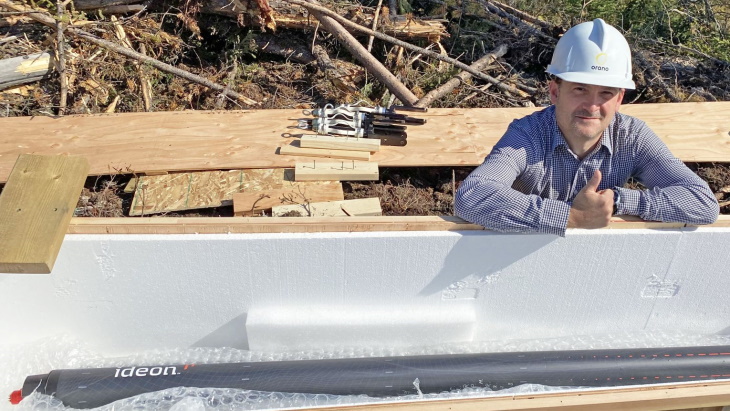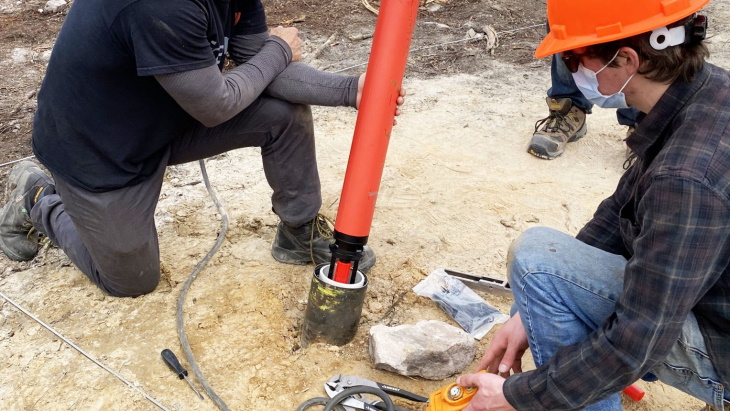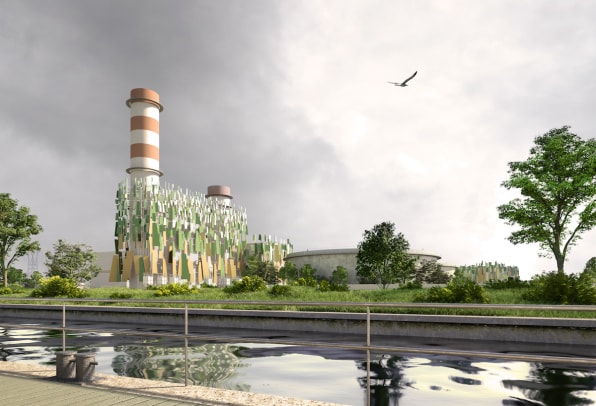Canadian firm enters US uranium sector with mine purchases
16 July 2021
Vancouver-based International Consolidated Uranium (CUR) has agreed to buy the Tony M, Daneros and Rim conventional uranium mines in Utah, as well as the Sage Plain property and eight Department of Energy leases in Colorado from Energy Fuels Inc. In addition, the companies have agreed to enter into toll-milling and operating agreements with respect to the projects. The transaction positions CUR as a potential near-term US uranium producer.
.jpg?ext=.jpg)
The mines purchased by CUR from Energy Fuels (Image: CUR)
Under a definitive asset purchase agreement announced yesterday, CUR will pay Energy Fuels USD2 million at the closing of the transaction, CAD6 million (USD4.8 million) of deferred cash payable over time, up to CAD5 million of deferred cash payable on commencement of commercial production, and such number of CUR shares that results in Energy Fuels holding 19.9% of the outstanding CUR common shares immediately after closing. CUR will also pay Energy Fuels a management fee, along with a toll milling fee for ore produced at the acquired projects in the future.
The portfolio of projects being acquired by CUR includes, among other assets, three permitted, past-producing mines in Utah: Tony M, Daneros and Rim.
The Tony M mine in southeastern Utah is a large-scale, fully-developed and permitted underground mine. Located about 127 road miles west of Energy Fuels' White Mesa Mill, the mine was operated by Denison from September 2007 to November 2008, when it was placed on care and maintenance. In June 2012, Energy Fuels acquired all of Denison's uranium properties in the USA.
The Daneros mine - located about 70 miles west of the White Mesa Mill - is a fully-developed and permitted underground mine. It operated from 2009 until October 2012 when the mine was placed on standby by Denison.
The Rim mine is a permitted, formerly producing mine located approximately 62 road miles from the White Mesa Mill. The mine has operated historically on a periodic basis starting in the mid-1960s. Mining last occurred in early 2008 by Denison and ceased in late 2010. Energy Fuels acquired the property in 2012 and has maintained it on care and maintenance since that time.
The transaction also includes CIR's acquisition of the Sage Plain property in Utah and eight Department of Energy (DOE) leases in Colorado. The project area - some 54 road miles from the White Mesa Mill - is at the location of the historic Calliham mine. The DOE leases are located in the historically productive Uravan Mineral Belt in Colorado. The leases are located 80-175 road miles from the White Mesa Mill. New 10-year leases for these lease tracts were executed by Energy Fuels in January 2020.
Strategic alliance
CUR and Energy Fuels have also entered a strategic alliance for the projects, which involves three key components: a toll-milling agreement, operating agreements and an investor rights agreement.
Under the toll-milling, Energy Fuels will toll-mill ore mined from the projects at the White Mesa Mill, subject to payment by CUR of a toll-milling fee and certain other terms and conditions. With this agreement, CUR will become the only current US uranium developer - other than Energy Fuels itself - with guaranteed access to the White Mesa Mill, which is the only permitted and operating conventional uranium mill in the USA.
Through the operating agreements, Energy Fuels will provide ongoing services for a fee to maintain the projects in good standing, as well as additional services as agreed to by the parties.
Under the investor rights agreement, for so long as Energy Fuels' equity ownership in CUR remains at or above 10%, it will be entitled to equity participation rights to maintain its pro rata equity ownership in CUR and to appoint one nominee to the CUR Board of Directors.
Growth strategies
"Our strategy has been to acquire uranium projects around the world, create critical mass, and target the acquisition of larger, more advanced projects," said CUR President and CEO Philip Williams. "While the recently announced acquisition of the high-grade Matoush Project in Quebec was a big step forward for CUR, today's acquisition and alliance with Energy Fuels represents a giant leap. In one transaction, we are entering the important US uranium sector by acquiring past producing mines which are permitted and well positioned for a rapid restart when market conditions are right."
CUR has acquired a 100% interest or has entered into option agreements to acquire a 100% interest in seven uranium projects, in Australia, Canada and Argentina, each with significant past expenditures and attractive characteristics for development.
Energy Fuels holds three of the USA's key uranium production centres: the White Mesa Mill in Utah, the Nichols Ranch ISR Project in Wyoming and the Alta Mesa ISR Project in Texas. The White Mesa Mill is the only conventional uranium mill operating in the USA today, has a licensed capacity of over 8 million pounds of U3O8 per year and has the ability to produce vanadium when market conditions warrant.
"The assets we are selling to CUR are proven US uranium mines, and in fact production from these mines since 2006 has accounted for over 1,050,000 lbs of US uranium production, which would rank those mines as fifth among all current uranium producers in the US over those years," said Energy Fuels President and CEO Mark Chalmers.
"However, because Energy Fuels is focusing its attention on its core projects - the Nichols Ranch and Alta Mesa ISR properties and the Pinyon Plain, La Sal and other conventional properties - we do not believe markets have properly valued the projects within our expansive portfolio of exceptional assets," he added. "We believe that, in order to realise the full value of our expansive portfolio, certain assets, such as the projects, can be repositioned to the benefit of Energy Fuels and its shareholders, provided we find the right vehicle to unlock the value of these assets. In this transaction, we believe we have found that vehicle in CUR."
Transformative muon technology deployed at McClean Lake
07 July 2021
The world's first cosmic-ray muon detector developed specifically for use in industry-standard boreholes, has been deployed at Orano's McClean Lake site in northern Saskatchewan where it will be used to image a uranium deposit. The technology developed by Canadian start-up company Ideon Technologies could transform mineral exploration

Orano Canada Exploration Technical Director Rémy Chemillac with the borehole muon detector (Image: Ideon)
Muon tomography uses muons - naturally occurring subatomic particles created when cosmic rays enter Earth's upper atmosphere - to provide x-ray-like imaging up to 1 km beneath the Earth's surface. This means that new mineral and metal deposits can be identified with precision and confidence, with less need for drilling, reducing costs and risks, saving time and minimising environmental impact.
Ideon - a spin-off of Canada's TRIUMF national particle accelerator laboratory - has developed a discovery platform which integrates proprietary muon detectors, imaging systems, inversion technologies, and artificial intelligence to produce high-resolution 3D density maps of underground targets. The company has been working with Orano since 2016, when its first-generation large format detectors were used to image a high-grade uranium deposit under 600 m of sandstone at the McArthur River mine.
A miniaturisation effort has led to the development of the first industry-standard borehole (less than 10 cm in diameter), low-power (less than 10W continuous power consumption), zero-maintenance muon tomography detector suitable for operation in the extreme environmental conditions of mineral exploration sites around the world. Its deployment is a milestone that has taken more than a decade to reach, Ideon CEO Gary Agnew said.

Deploying the detector in the borehole (Image: Ideon)
"We've spent seven years doing commercial trials in partnership with the mining industry and several years of system design and development, de-risking and prototyping in the lab," he said. "Orano has been there right along with us for much of that journey, leading the way as a customer-driven innovator in the global energy transition. We are grateful for their enthusiasm, flexibility, trust, and willingness to break new ground with us."
Hervé Toubon, R&D and innovation director at Orano Mining, said the company expects the project to "transform the very nature" of exploration. It is "virtually impossible" to detect high-grade deposits at depth using traditional geophysical exploration techniques, he said. "The subsurface intelligence we gain with muon tomography gives us the ability to accurately locate those anomalies while reducing the need for drilling and lowering our overall environmental impact. That value proposition is hard to beat."
Orano's imaging target is a high-grade, compact uranium deposit located at a depth of 300 m. Multiple borehole muon detectors are deployed down a single drill hole in a connected sequence, delivering progressive imaging results throughout the survey. The McClean Lake project, which is approved by the Eureka intergovernmental R&D funding and coordination organisation, is receiving advisory services and funding support from the National Research Council of Canada Industrial Research Assistance Program and will run until the end of 2021.
In addition to muon tomography models, Ideon said it will also work with Orano to develop joint inversions with existing drill data and other geophysical datasets.
Muon detection systems have also been used to investigate passively the contents of legacy waste containers at Sellafield in the UK and to investigate the location of molten fuel within the damaged reactors at the Fukushima Daiichi plant in Japan.
Cigar Lake to resume operation as wildfire risk passes
05 July 2021
Workers are returning to the Cigar Lake uranium mine in northern Saskatchewan, Canada, ahead of its planned restart later this week, Cameco has announced. All non-essential personnel were evacuated last week from the site as a precaution due to the proximity of a nearby wildfire
..jpg?ext=.jpg)
Cigar Lake (Image: Cameco)
Cameco announced on 1 July that it had decided to evacuate about 230 workers from the Cigar Lake site. Around 80 personnel remained to secure the site and for essential duties. At that time, the company said: "The situation is complicated by extremely warm, dry weather, resulting from the heat dome that has settled over western Canada in recent days, along with variable wind and smoke conditions."
On 2 July, Cameco said the wildfire had moved past the main camp area without serious impact to the site itself. "While our inspections continue, we believe no structural damage has occurred to any buildings and all assets appear intact," it said.
Yesterday it announced, in consultation with provincial wildfire management officials from the Saskatchewan Public Safety Agency, it believed the risk to Cigar Lake posed by the fire had now subsided.
"With improved weather and smoke conditions, minimal likelihood of further road closures in the area, and all infrastructure at Cigar Lake remaining intact, Cameco believes the full complement of personnel can be safely remobilised and regular operations resumed," it said.
Cameco is now in the process of transporting employees and contractors back to the Cigar Lake site. Final inspections and preparation of equipment will occur over the days ahead to ready the operation for a return to production.
Cigar Lake is the world's highest grade uranium mine and has produced a total of over 93 million pounds U3O8 since it was commissioned in 2014. Ore from Cigar Lake is processed at the McClean Lake mill, 70 kilometres from the mine, which is operated by Orano. Uranium production at Cigar Lake was suspended due to restrictions created by the COVID-19 pandemic for five months from March 2020, and for a second time in December, resuming in April.
Researched and written by World Nuclear News














.jpg?ext=.jpg)
.jpg?ext=.jpg)
.jpg?ext=.jpg)


.jpg?ext=.jpg)